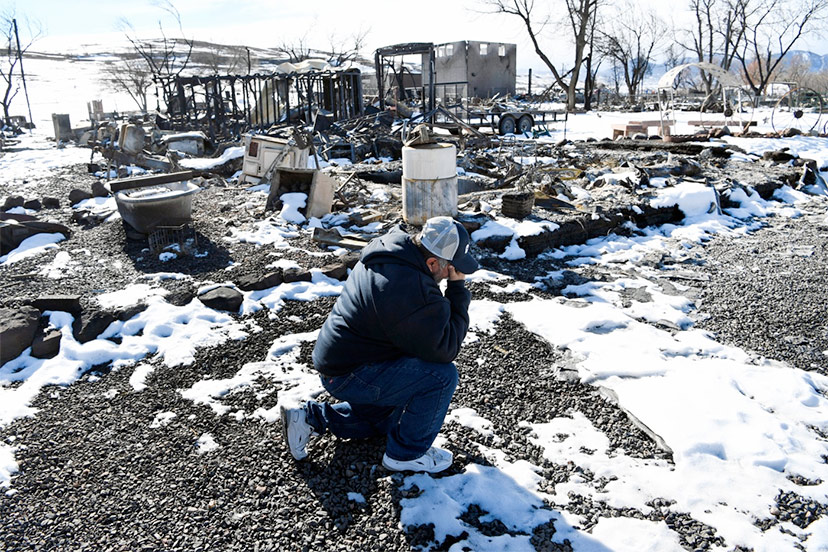This story by Robert Davis appeared on Colorado Newsline on July 25, 2022.
Some homeowners like the Plazures of Denver wonder whether climate change and inflation will force them to leave Colorado because of how these issues are impacting homeowners insurance policies. (Courtesy of Craig Plazure)
Craig Plazure and his wife, Morgan, describe themselves as two of the “lucky ones” who were able to buy a home in Colorado in August 2021. But after settling down and having two children, the family is wondering how long they’ll be able to stay in Colorado because of their rising homeowners insurance premiums.
The Plazures moved into a 130-year-old home in central Denver’s Whittier neighborhood because of its access to City Park, the Madison Recreation Center, and the walkable area. Their homeowners insurance policy carried an annual price tag of around $1,800, but after a summer of extreme weather, the family received a letter from the bank saying their premium was going up by more than 20%.
Like many households in Colorado, the increased forced them to look for areas where they can cut costs as inflation continues to increase the prices of necessities like food, energy and child care.
“People are being squeezed in every way,” Plazure told Colorado Newsline. “And I think this is just another example.”
Homeowners insurance often represents a small fraction of a homeowner’s annual budget, but it can be one of the most consequential payments. These insurance policies cover everything from the home itself to its contents in the event of damage.
As Colorado’s climate continues to produce extreme weather and natural hazards, homeowners are seeing their premiums rise much faster than many expected. According to a report from Policygenius, an online insurance marketplace, homeowners in Colorado saw their premiums rise by an average of 17.5% over the last 12 months, which was the third-highest increase in the country.
One reason for the steep increases is climate change, according to Pat Howard, a property and casualty specialist at Policygenius. And Colorado homeowners saw how devastating this phenomenon is becoming in December, when the Marshall Fire in Boulder County razed more than 1,000 homes and caused upwards of $500 million in damages, according to local estimates.
On top of climate change, the cost of rebuilding homes has also increased because of both inflation and supply chain issues. Data from the National Association of Home Builders shows that building material prices have increased by 20.4% over the last year and 33% since the pandemic began in March 2020.
“As these costs spike, you’ll often see insurance rates do the same,” Howard told Colorado Newsline.
For Colorado families like the Plazures, the rising premiums carry real-world implications. The Plazures welcomed twins into their life in January and are now paying for in-home child care, because they couldn’t find a center with room for both of their kids. This comes at a time when prices for necessities like groceries and home energy have risen by 10.6% and 11.7%, respectfully, according to the Bureau of Labor Statistics.
Plazure said his family was able to negotiate a minimal increase to their homeowners insurance rate with their agent but added that many households in Colorado may not be as fortunate.
“We were lucky that our overall increase wasn’t as bad as the bank said it could be,” Plazure said. “But these issues aren’t going away any time soon, so what’s going to happen next year… if we have more wildfires and other extreme weather?”
Some insurance brokers like Todd Berg, who owns Spotlight Insurance in Denver, have been fielding calls from clients asking similar questions for more than a year. Homeowners insurance is typically one place where families look to save a few bucks for their annual budget, but right now “that’s a double-edged sword,” Berg told Newsline.
Berg said he has been fielding “more calls than ever” from clients looking to reduce their annual premium payments. But doing so can lead to drops in coverage levels and create situations where homeowners are underinsured when a catastrophe like the Marshall Fire hits.
These increases can be especially impactful for families like the Plazures who live in older homes because the building materials are often older than local building codes allow.
Homeowners who can’t afford to upgrade their roof or water pipes, for example, often see the steepest insurance premium increases, Berg said.
But, state agencies such as the Division of Insurance, which is responsible for overseeing Colorado’s insurance marketplace, are just starting to understand how these insurance rate increases are impacting different communities in the state.
In 2021 the General Assembly passed Senate Bill 21-169, which requires DOI to investigate the underwriting and rating practices for marginalized communities. However, Vincent Plymell, a spokesperson for the Division, said the agency will first look into how this impacts life insurance policies before moving on to other types of insurance.
While these studies are underway, Plazure said their homeowners insurance rate increase has made them reconsider raising their young children in Colorado. The state is getting hotter, and temperatures have been near 100 degrees Fahrenheit five times in the last week alone. At the same time, Denver’s air quality continues to be a concern.
“You don’t want to have to check the air quality just to take the babies on a walk in the morning,” Plazure said. “This isn’t just a regional problem either. I think people are starting to realize that this is a national, if not global, issue.”

